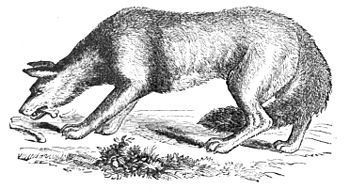short, brownish, ash-colored fur, of considerable value, which has been largely exported to Europe for making hats. It has also been much used here for hats, gentlemen's sets, and other purposes. The fur somewhat resembles that of the beaver, as well as the otter. It is estimated that 3,000,000 are caught annually.
The muskrat, or musquash, is a native of North America, much smaller than the beaver, but with habits and appearance somewhat similar. Muskrats feed upon mussels, aquatic plants, and roots of grasses, and build winter-huts of sticks, grass, and mud, with an entrance under water, leading to a dry apartment above. In summer they dwell in extensive burrows along the banks of the rivers. The trapper, walking on the bank, hears the muskrat run from his hole into the water, observes where he stirs the mud, and puts the trap quietly down there. The number of skins taken yearly by trap and gun is immense; over 3,000,000. Many are manufactured into hats on both sides of the Atlantic, more than a million being exported annually to England for that purpose. Besides hats, they are used here largely for men's gloves, ladies' sets, robes, etc. They are frequently dyed to imitate mink, and are then called Alaska mink. They are also plucked and dyed to imitate seal and similar furs.
Fig. 15.

Wolf. (Tenney.)
The chinchilla is scarcely larger than a rat, and inhabits the cold mountain-regions of Chili and Peru. It is chiefly remarkable for its exquisitely fine fur, which is very soft, and of a pearly gray. It is used for ladies' and children's sets, but more especially for lining and trimming cloaks, pelisses, and other articles of clothing. Not more than 100,000 are taken yearly.
The fur of the northern hare, which is white in winter and brown in summer, is mostly used in the manufacture of hats. The skins of the common European rabbit or French cony are used for ladies' sets and children's furs. The fur is also used for hats. Several millions are taken each year.
The fur of the skunk is used, under the name of Alaska sable, for
